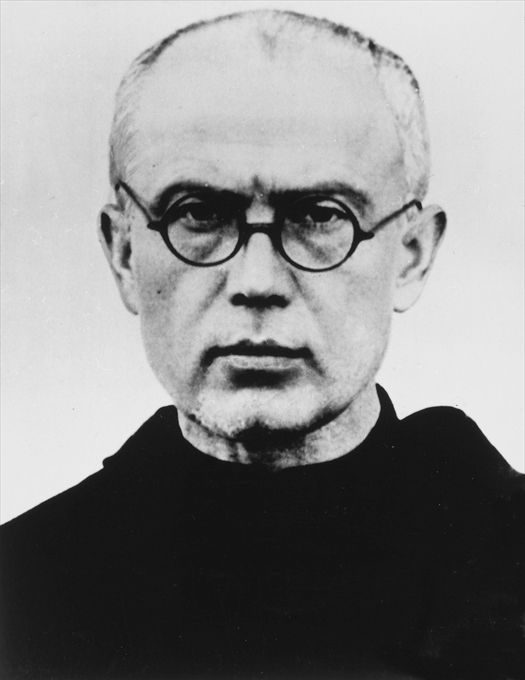As the storming German army approached, Kolbe and about forty of his Franciscan brothers eagerly awaited its impact. Despite the warnings of Polish officials, these men had decided to plant their feet in an almost deserted monastery. The Franciscans continued to remain prayerful and hopeful as German forces rapidly made their way towards the monastery. By the nineteenth of September, the German army had reached the city of Niepokalanow, where Kolbe and his brothers were residing in their monastery. Swiftly following an order given by their commanding officer, German soldiers rounded up Kolbe and his fellow Franciscans, and they were loaded into trucks that were destined for Czestochowa. When the trucks reached the city, the Franciscans were loaded onto a train, along with around six hundred civilian prisoners. As the train sped towards the German border, its passengers were unsure about their future. The passengers, or more specifically prisoners, could only assume that their destination would most likely be accompanied by pain and hardship. When the train arrived at the concentration camp of Amtitz, the prisoners were unloaded and sent to take their place within an already established system of humiliation. Although the treatment of prisoners at the concentration camp of Amtitz was wretched, the Nazi regime had not yet issued its exterminatory policy towards its prisoners. After a long and grueling few months, a commandant gathered three hundred prisoners, including the Franciscans, and informed them that they were being sent home. When they arrived back home in Niepokalanow, they found their city in shambles, and their church crippled by the plundering of the German army. Although they felt disappointed that a place of worship had been treated with such irreverence, they were still thankful that they had simply made it home alive.2

Back at home, Kolbe wasted no time as he voiced his condemnation of the acts of the Nazi regime. He wrote relentlessly to the authorities and demanded that justice be served to those who took advantage of the less powerful. He called for the resumption of the services provided by the monastery. This meant that he not only openly published his sentiments against the Nazi overlords, but also served the less fortunate in his community. For months, the monastery became a place of refuge and assistance for the local people. As 1940 began, the Nazis were demanding that they receive control of the fate of Poland. They had not yet waged war against most of Europe. Simultaneously, Kolbe’s reach grew and extended to refugees outside of Niepokalanow. Many fleeing Jews took refuge within the sanctuary that Kolbe had established. Kolbe’s actions were pushing him further into direct opposition with Nazi Germany, which had an overwhelmingly anti-Semitic agenda. With each generous act of charity, Kolbe moved one step closer to his fate. As the German army started to make its way into Nirpokalanow, slowly creeping closer and closer to the monastery, Kolbe and his brothers remained firm in their beliefs and practices, regardless of the fact that they were very quickly becoming a threat in the eyes of the opposition. Many encouraged Kolbe to escape while he still had a chance, but Kolbe only persisted in prayer and in open disapproval of the Nazi regime. By early 1941, the coexistence of Kolbe and the intruders could last no longer, and the German army gave Kolbe an ultimatum. German officials offered Kolbe German citizenship, which would allow his integration into the Nazi regime. If he declined this offer, he would become an enemy of Nazi Germany, and face the repercussions of his resistance.3 Without hesitation, Kolbe refused allegiance to Nazi Germany and therefore accepted the possible consequences that might incur. On February 17, 1941, Kolbe received news that German soldiers were making their way towards the monastery. Hearing this, he dressed in his Sunday habit and made his way to meet them at the entrance of the monastery. As the men approached, Kolbe greeted them by saying, “Praised be Jesus Christ,” and invited them inside. After showing them around the monastery, the soldiers announced that he was being arrested. Kolbe, without hesitation, handed himself over to his captors, and they departed.4
This time Kolbe was taken to Pawiak Prison in Warsaw, Poland. Upon his arrival, Kolbe was placed in a holding cell with many different people. Shortly after, the prisoners were evaluated and moved to separate cells. Although this setting kept Kolbe secluded from others most of the time, he took advantage of every opportunity to interact with his fellow prisoners. He was inspired to use every opportunity he had with others to teach them about his faith and to bring a sliver of joy to their bleak reality. Kolbe’s mission had its repercussions in the form of repeated beatings by Nazi sergeants.5 They took every opportunity to display their power and superiority, and jumped at the chance to take out their hatred on religious people. After a short stay at Pawiak, Kolbe was given the news that he was being relocated to Auschwitz.6
Auschwitz was a place where people went to die, either quickly or slowly. The only variation in the fates of the prisoners came through how they would perish. Would it be by starvation, exhaustion, torture, or mass execution? Only time would tell. Auschwitz ran on a perpetual cycle of extermination: prisoners were used for labor and experimentation, and subsequently thrown away like useless objects. The malnourished captives constantly had the misery of their reality enforced by psychotic guards who were encouraged to torture and abuse the prisoners to the furthest extent. Kolbe would reside in this dark and grim world for the last few months of his life. The love in his heart illuminated his surroundings and touched anyone who had the privilege to interact with him. Kolbe continued his ministry by talking with those incarcerated with him and bringing them the Word of God. Those who conversed with Kolbe at this time described him as an unfathomably joyous man. Prisoners who observed him from afar were overwhelmed by the compassion Kolbe showed to everyone he met. No one could understand just how someone could put the needs of others so far above their own. Because of his charitable actions and religious status, Kolbe was often singled out for extensive amounts of torture.7

On the last night of July, in 1941, alarms sounded signaling an attempted escape. A baker from Warsaw had escaped the camp and was evading the authorities. Whenever a situation like this would arise, the guards would be given the order to select ten prisoners to be starved until the escapee was found. However, this procedure was a lie. Those chosen would never be spared, even if the prisoner happened to be found. The following evening, Commandant Karl Fritsch announced that he would be selecting ten individuals to be starved to death. Among the group that was chosen was a man by the name of Francis Gajowniczek. When he was chosen, he began sobbing with despair and cried out that he had a wife and children. Without hesitation, Kolbe took a few steps forward and informed the prison official that he would like to offer himself in place of Gajowniczek. The German official asked him his profession, and Kolbe responded that he was a priest.8 The German official approved, and Gajowniczek was told to return to his place in line, with the others who had been spared. With that, Kolbe and the other unfortunate prisoners were taken to a bunker in Barrack 11 to be starved. The bunker was a desolate and cold place, and the prisoners were ordered to strip naked. Over the following days, the prisoners’ bodies would slowly deteriorate as dehydration and starvation set in. Within days, most of the group had perished, and the ones left were experiencing hallucinations and constant, severe anguish. However, those who passed by the bunker later claimed that Kolbe seemed to be exempt from these ailments. Indeed, he was reported to be in a constant state of meditation and prayer. When a fellow prisoner would pass, he would pray over them. After fourteen days, the prison guards were ordered to clear the prison cell. Seeing that Kolbe was still alive, a guard was ordered to inject Kolbe with a syringe of phenic acid. It is said that Kolbe extended his arm and willingly accepted his fate.9
It would be thirty-five years before Catholic Church officials would discuss the status of Kolbe within the church. Pope John XXIII was charged with the task of declaring if Kolbe would be considered a white or red martyr. White martyrs are those who choose to let their worldly pleasures die in order to take on a life of minimalism. Red martyrs are those who give their actual life in service to their faith. Pope John XXIII decided to declare Kolbe a white martyr. He felt that Kolbe’s actions were heroic, yet argued that they fell short of the actions typically associated with red martyrs. This action was later modified during the papacy of Pope Saint John Paul II, who canonized St. Maximilian Kolbe on October 10, 1982, and officially declare him a red martyr. Present at the canonization was Francis Gajowniczek, who was ninety-four at the time. The selflessness and courage of St. Maximilian Kolbe is a relatively modern example of an individual who did not waver in the face of persecution. Kolbe demonstrates the epitome of what it means to be a faithful servant of both one’s fellow man and God. His contribution to others didn’t end with his decision to sacrifice his life for another, and it continues to inspire those who hear his story to strive to live with humility, faith, courage, and love.10

- Andre Frossard, Forget Not Love (San Francisco: Ignatius Press, 1991), 157,158. ↵
- Andre Frossard, Forget Not Love (San Francisco: Ignatius Press 1991), 158,159,160. ↵
- Andre Frossard, Forget Not Love (San Francisco: Ignatius Press, 1991), 171,172,173,174. ↵
- Robert Royal, The Catholic Martyrs of the Twentieth Century: A Comprehensive World History (New York: Crossroad Pub Co., 2006), 206,207. ↵
- Andre Frossard, Forget Not Love (San Francisco: Ignatius Press, 1991), 175,176,177,178,179. ↵
- Robert Royal, The Catholic Martyrs of the Twentieth Century: A Comprehensive World History (New York: Crossroad Pub Co., 2006), 206. ↵
- Tejvan Pettinger, “Biography of Maximilian Kolbe,” Biography Online, August 3, 2014, https://www.biographyonline.net/spiritual/maximilian-kolbe.html. ↵
- Richard P. McBrien, Lives of the Saints: from Mary and St. Francis of Assisi to John XXIII and Mother Teresa (San Francisco: HarperSanFrancisco, 2003), 328,329,330. ↵
- Andre Frossard, Forget Not Love (San Francisco: Ignatius Press, 1991), 193,194,195,196,197. ↵
- Andre Frossard, Forget Not Love (San Francisco: Ignatius Press, 1991), 185,186,187. ↵



44 comments
Raul Colunga
It is hard to put into words the amount of defiance Maximilian Kolbe had against the Nazis. In a way it could be seen as stubbornness because plenty of times he could have escaped but instead held his ground and stood up for what he believed. I’m glad that his story was able to be heard because he did what a lot of people could or would not do.
Nelly Perez
Kolbe was an interesting saint. He preached his voice for many reasons and decided to use it against or on the Nazi regine. Kind of surprised that this was during World War II. He and his brothers have strong faith in each other. I wonder how Kolbe and his brothers felt when German army soldiers came up to them. They must’ve panicked.
Kasandra Ramirez Ferrer
This is a really good article, no wonder it got nominated, it tells the story in a perfect way. After reading the article, I can tell that Maximilian Kolbe was truly what people can a saint for all the sacrifices that he did during his lifetime. He could have been selfish but he had faith in God and truly believed his word and lived according to it.
Emmanuel Ewuzie
Maximilian Kolbe was unselfish. His constantly sacrificing himself and putting others’ well beings over his own is nothing short of an anomaly. Maybe once or twice it would be considered just a stretch of good deeds but he did it time and time again signifying that it was simply his nature. The courage and confidence Kolbe showed in face of imminent danger was nothing short of incredible.
Sebastian Azcui
Great article! It was very well-written and very organized.I did not know who Maximilian Kolbe was and what he did. Maximilian sacrificed himself and he is a true disciple of God. He sacrificed everything to God, his body and his life. He showed how he can help the ones in need and do others things for everyone, such as praying for them.
Dr Celine
What a powerful story of the most positive qualities of humans: faith, selflessness, and sacrifice in response to the worst some humans chose to display during a very dark time. Your article is able to describe some of the very painful and dehumanizing treatment at the hands of Nazis while showing the hope, faith, strength, resilience, and the tough sacrifice made by Saint Maximilian Kolbe. Your introduction had a very powerful way of drawing the reader in and of exposing some dark details of history in nuanced ways. You wrote about a time very important to me as I grew up hearing stories of French Resistance from my grand mother. So any story of resisting to Nazi Germany takes me back to times when my grand mother nurtured my love for history and for remembering those who chose to do the right thing during the toughest times at the price of their freedom and life. Outstanding.
Pablo Ruiz
Wow this is a great article. I have never heard of Maximilian Kolbe or any of his heroic acts. It was admirable how he decided to not flee Poland and just spread the word of God. When Kolbe volunteered to be starved it showed how he cared more about helping others than himself. When he mediated for the 14 days and stay alive it showed the power of God and his connection with his fate.
Cassandra Sanchez
Maximilian Kolbe is truly worthy to be named a saint for all his sacrifices to help and save others above himself. He chose to take a stand and accept whatever consequences came to him instead of fleeing from where he was to safety. I think it is truly a miracle that he outlived the tortures of the ten other men and the starvation he faced and I believe he was guided by his faith and prayer which kept him alive until he was injected with acid.
Vanessa Quetzeri
It is very admirable for Maxamillian Kolbe to keep his stance in the face of persecution and been declared a martyr. I have never heard of a red or white martyr, but I now know that there is a difference in the service they do throughout their life for God. He, to this day, continues to inspire many in humility and forgiveness.
Andrea Degollado
This article was very well-written. I had never heard of Maximillian Kolbe and from the article i thought it was about a killer, but it was something different. Maximillian Kolbe is a red martyr he gavels life for the word of god. It is stories like this that fascinate me, people faiths are so strong they are willing to sacrifice everything, including their own lives for God. Great Article, very interesting!